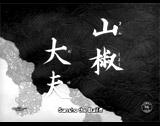
|
Sansho the Bailiff (1954, Jp.) (aka
Sanshô Dayû)
In Kenji Mizoguchi's very moving and sad drama (about
a family torn apart) - set in medieval 11th century Japan during
a time of warring social classes ("an era when mankind had not
yet awakened as human beings"):
- the wise advice of feudal governor and father Masauji
Taira (Masao Shimizu), given to his young son Zushio (Yoshiaki
Hanayagi) - along with a small golden statue-amulet representing
the Goddess of Mercy, Kwannon: "Without mercy, man is like
a beast...Even if you are hard on yourself, be merciful to others.
Men are created equal. Everyone is entitled to their happiness"
- the devastating sequence of the separation of the
family - the lakeside seizure of mother Tamaki's (Kinuyo Tanaka)
daughter Anju (Kyôko Kagawa) and son Zushiô, who were
sold to the estate of Sanshô (Eitarô Shindô), a
ruthless, cruel and corrupt bailiff, tax-collector and manager of
a lordship's manor, who maintained a large slave contingent; the
two children became indentured servants, and the mother was sold
into prostitution on Sado Island
- a new slave girl brought news of the mother (via an
evocative song with their original names: "Zushio, how I long
for you, Anju, how I long for you") - this confirmed that the
mother (now a courtesan) was still alive (although with a new name,
Nakagimi); it was learned that she had made many attempts to escape,
so that her captors had cut her Achilles' tendons
- the use of sound joined together the mother and her
now-grown children - ten years later, when she called to them from
a hilltop: "Zushio...Anju!" (although the two had taken
different names to conceal their identities, Shinobu and Mushu)
- Mushu's neglect of his father's advice as he became
a barbaric henchman for Sansho and carried out murder and torture
(branding) of other slaves
- during an escape sequence by the two children, the
tragic scene of Anju's self-sacrificial drowning (off-screen) in
a lake (to avoid capture and torture - "Isn't life torture?" -
and not reveal her brother's location) - she slowly walked into deepening
water, and her death was symbolized only by peaceful ripples on the
lake's surface
- the nihilistic sequence, when the former slaves were
freed by a converted Zushio (who had escaped and was appointed governor),
and they revolted and burned down Sanshô’s manor, and
exiled the nefarious bailiff
- after twenty years, the tearful reunion of Zushio
with his hobbled, half-mad mother (now aged, lame and blind, and
with a shattered life), on the tsunami-devastated beach of the island
of Sado, when he heard his mother's singing - at first she didn't
believe he was her son, and then was saddened to hear when he revealed
that both Anju and her husband were dead: "It's just you and
I. We're all alone now" - he claimed that he had finally adopted
his father's teachings: "I could have come for you as a governor,
but I gave up my title in order to follow Father's teachings. Please,
Mother, forgive me!" - she responded: "What nonsense do
you speak of? I don't know what you have done, but I know that you
followed your Father's teachings. And that is why we have been able
to meet again"
|
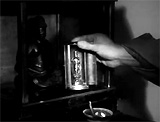
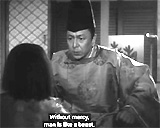
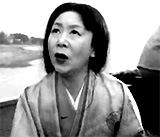

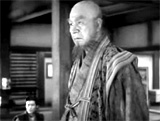
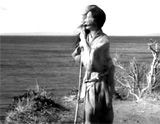

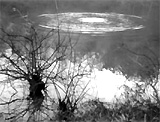

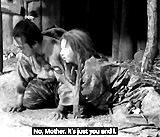
|











